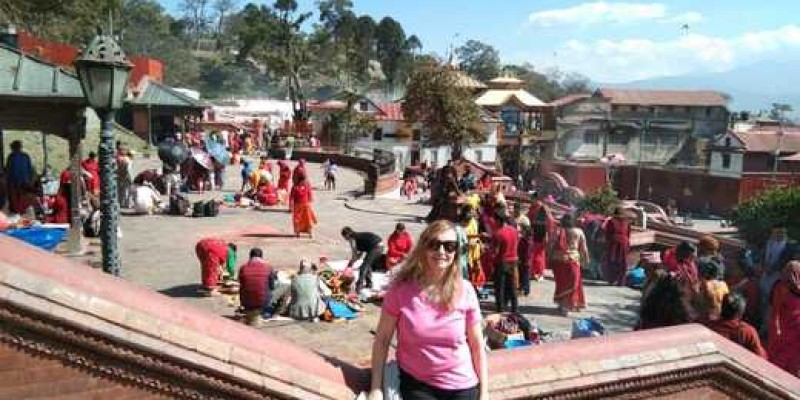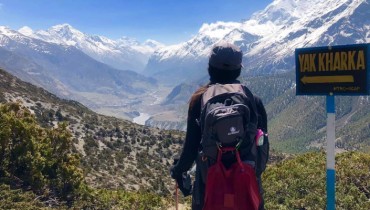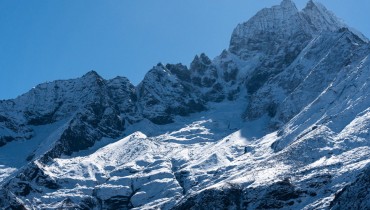22 Shocking Facts About Nepal

Introduction; Nepal is a beautiful country nestled in the lap of the Himalayas. It is a small landlocked country located between India and China. Nepal is famous for its natural beauty, cultural diversity, and adventurous activities. However, there are many things that most people do not know about Nepal. In this article, we will explore 22 shocking facts about Nepal that will surprise you.
- Unique flag
The flag of Nepal is not rectangular or square like most flags. Instead, it is a unique two-triangular pennant shape. The two triangles are stacked on top of each other, with the upper triangle being smaller and located above the lower triangle. The upper triangle is colored blue and represents the sky, while the lower triangle is colored red and represents the Himalayan Mountains and the bravery of the Nepali people. In the center of the flag is a white stylized depiction of the moon and sun.
- Mt. Everest, the top of the world
Nepal is home to the highest peak in the world, Mount Everest, which stands at 8,848 meters (29,029 ft) tall. The mountain was named after Sir George Everest, a British surveyor who was the first to determine its exact location and elevation. However, the local Nepali name for the mountain is Sagarmatha, which means "forehead in the sky," and the Tibetan name is Chomolungma, which means "goddess mother of the world."
- Buddha was born in Nepal
Nepal is the birthplace of Lord Buddha, the founder of Buddhism. The country has many pilgrimage sites for Buddhists, including Lumbini, where Buddha was born.
- The Gurkhas
Nepal is home to the Gurkhas, a group of soldiers who have served in the British Army for over 200 years. They are known for their bravery, loyalty, and fighting skills, and have earned a reputation as some of the toughest soldiers in the world.
The Gurkhas' association with the British Army began in the early 19th century, when the British East India Company was expanding its control over India and the surrounding regions. The company began recruiting soldiers from Nepal, a country known for its martial traditions and fierce warriors.
Gurkhas have fought in many conflicts over the years, including both World Wars, the Falklands War, and the wars in Iraq and Afghanistan. They have earned numerous honors and awards for their service, including the Victoria Cross, the highest award for bravery in the British military.
Today, Gurkhas continue to serve in the British Army, as well as in the armies of other countries, including India, Brunei, and Singapore. They are highly respected for their military prowess, discipline, and loyalty, and are widely regarded as some of the world's most elite soldiers.
- Kumari, the living Goddess
Nepal is the only country in the world with a living goddess, the Kumari. She is a young girl chosen through a rigorous selection process to be the embodiment of the Hindu goddess Taleju.
- Languages & ethnic groups
Nepal has over 123 languages spoken by its population, which consists of more than 100 ethnic groups. Probably, it is the only country that has a huge diversity within such a little territory. Here are some of the major ethnic groups and languages spoken in Nepal:
Ethnic Groups:
Khas/Chhetri - 16.6%, Magar - 7.1%, Tamang - 5.8%, Newar - 5.0%, Tharu - 4.8%, Brahmin - 4.7%, Rai - 2.8%, Gurung - 2.0%, Limbu - 1.8%, Sherpa - 1.4%,
Languages:
Nepali - 44.6% (official language), Maithili - 11.7%, Bhojpuri - 6.0%, Tharu - 5.8%, Tamang - 5.1%, Newari - 3.2%, Magar - 3.0%, Awadhi - 2.3%, Limbu - 1.5%, Gurung - 1.4%
- Calendar
Nepal has a unique calendar system called the Bikram Sambat, which is 56.7 years ahead of the Gregorian calendar. The Nepali New Year is celebrated in mid-April, and the calendar is widely used in Nepal and parts of India.
- Yeti, the snowman
The Yeti, also known as the Abominable Snowman, is said to roam the Himalayas, including parts of Nepal. Many locals believe in its existence.
- Lukla airport
Nepal is home to the world's most dangerous airport, the Lukla airport, which is often referred to as the "Gateway to Everest." The runway is only 527 meters long, and the planes have to take off and land on a steep incline.
- Unique festivals
Nepal celebrates a unique festival such as Bisket Jatra and Gai Jatra.
Bisket Jatra; a traditional festival that is celebrated in Bhaktapur, a historic city located on the outskirts of Kathmandu, Nepal. The festival is celebrated in April and is one of the most important and popular festivals in the Kathmandu Valley.
Bisket Jatra is a week-long festival that is marked by the raising of a tall wooden pole, known as a "lingo," which is believed to represent Lord Bhairava, a fierce and powerful deity. The festival also features a large procession of people, who carry colorful chariots, or "raths," through the streets of the city.
The highlight of the festival is the pulling of the chariots, which takes place on the last two days of the festival. The chariots are pulled by groups of young men, who compete with each other to see who can pull their chariot the farthest. The pulling of the chariots is considered to be a sacred and auspicious act, and it is believed to bring good luck and prosperity to those who participate.
Gai Jatra; a festival that is celebrated in Nepal, particularly in the Kathmandu Valley, during the month of August or September. The festival is celebrated to honor and remember the loved ones who have passed away during the previous year.
During Gai Jatra, families who have lost a loved one during the previous year participate in a procession through the streets, with a cow or an image of a cow leading the way. The cow is considered to be a sacred animal in Nepal and is believed to help guide the deceased on their journey to the afterlife.
Participants in the procession also wear costumes and perform dances and skits, often with a humorous or satirical tone. The festival is intended to be a joyful celebration of the lives of the departed, and it is believed that the festivities can help ease the grief of those who are mourning.
- Practicing Chhaupadi
Chhaupadi is a harmful traditional practice that is still prevalent in some parts of Nepal, particularly in remote rural areas in the west parts. It involves banishing menstruating women and girls, as well as those who have just given birth, from their homes and forcing them to live in small, poorly ventilated huts or sheds, often with no access to clean water or proper sanitation facilities. This practice is based on the belief that women are impure during their menstrual periods, and it is intended to protect the family and community from bad luck or misfortune.
- Worshiping cows and dogs
It is true that in Nepal, cows and dogs hold a significant cultural and religious importance, and are often revered and worshiped by many people.
Cows are considered sacred in the Hindu religion, which is the predominant religion in Nepal, and are often seen roaming freely on the streets and countryside. They are considered as a symbol of wealth and prosperity, and their milk is used in many religious ceremonies and offerings. In addition, the cow's urine and dung are believed to have medicinal properties and are used in Ayurvedic medicines.
Similarly, dogs are also highly valued in Nepal and are considered to be loyal companions and protectors. In some parts of the country, dogs are worshipped during the festival of Kukur Tihar, which is also known as the festival of dogs. During this festival, dogs are decorated with garlands of flowers and given special treats as a way of honoring their loyalty and companionship.
It is worth noting that while cows and dogs are revered in Nepal, they are not the only animals that hold cultural and religious significance. For example, monkeys are also considered sacred in some parts of the country, and are believed to be the incarnation of the Hindu god Hanuman.
- Rhododendron kingdom
Rhododendron is the national flower of Nepal and is widely found throughout the country, particularly in the hilly and mountainous regions. There are over 30 species of rhododendron in Nepal, ranging in color from white to pink, red, purple, and even yellow.
Nepal is home to the world's largest rhododendron forest, which covers over 32,000 hectares in the Langtang National Park.
- Never colonized
While Nepal has a long and proud history of independence, it is not entirely accurate to say that Nepal was never under any foreign invasion. Throughout its history, various neighboring powers have attempted to invade or exert influence over Nepal, with varying degrees of success.
Nepal has never been colonized or occupied by a foreign power, and the country has a long and proud tradition of resisting foreign influence and preserving its independence.
- MoMos
Momo is a type of steamed dumpling that originated in Tibet, but is one of the most popular cuisine in Nepal too. It is a staple food in these regions and is often eaten as a snack or as a main meal. Momo is typically made with a mixture of minced meat (usually chicken, pork, or beef), vegetables (such as onion, cabbage, and carrots), and spices, which are wrapped in a dough made from flour and water. The dumplings are then steamed in a special steamer until they are cooked through and the dough is soft and tender. Momo is often served with a dipping sauce made from tomatoes, chili peppers, and other spices, which gives it a spicy and tangy flavor. It is a delicious and popular food that has become famous all over the world, and is now available in many Nepalese and Tibetan restaurants around the globe.
- Caste system
The caste system is an ancient social hierarchy that has been a significant part of Nepali society for centuries. In Nepal, the caste system is known as the "jāti" system and is based on birth and hereditary occupation. There are four main caste groups in Nepal: Brahmins, Kshatriyas, Vaishyas, and Shudras, with each group having its own sub-castes and hierarchies.
Traditionally, Brahmins are considered to be the highest caste, followed by Kshatriyas, Vaishyas, and Shudras. This hierarchy has historically had a significant impact on the social, economic, and political structures of Nepali society, with members of lower castes facing discrimination, marginalization, and limited opportunities for education, employment, and social mobility.
While the caste system is officially outlawed in Nepal, it remains a significant challenge, particularly in rural areas, where traditional beliefs and customs are more deeply ingrained. Discrimination based on caste is still prevalent in many areas of Nepali society, and there have been ongoing efforts to address these issues, including through legal reforms, education, and awareness campaigns. However, progress has been slow, and the caste system continues to be a significant challenge in Nepal.
- Rich in water resource
Nepal has over 6000 rivers, including the Koshi, Gandaki, and Karnali, making it one of the most water-rich countries in the world. It is the second richest country in running water resource in the world after Brazil.
- Beef is not available in butcher shops
Nepal is a predominantly Hindu country, and cows are considered sacred in Hinduism. As a result, the slaughter of cows and the consumption of beef are prohibited by law in Nepal. This means that beef is not available in shops in Nepal, and those who want to eat beef have to obtain it illegally or import it from neighboring countries.
- Daal-Bhat
Daal-Bhat is a traditional Nepali dish that consists of cooked lentils (daal) and rice (bhat). It is a staple food in Nepal and is usually eaten twice a day, once for lunch and then for dinner. Daal-Bhat is often served with various side dishes such as vegetable curries, pickles, and sometimes meat or fish.
- The deepest Gorge in the world
Nepal has the deepest gorge on earth. The Kali Gandaki Gorge aka “Andh Galchhi” located in Myagdi district, Nepal. The Kali Gandaki River flows through this gorge, which is situated between the Dhaulagiri and Annapurna mountain ranges in the Himalayas.
The Kali Gandaki Gorge is approximately 14,000 feet (4,300 meters) deep, making it one of the deepest gorges in the world. It is also a popular trekking destination, with stunning views of the surrounding Himalayan peaks, including Dhaulagiri and Annapurna.
- Kathmandu was once a lake
According to mythology, Kathmandu Valley was once a lake known as Nagdaha. The valley was said to have been inhabited by a giant serpent or Naga named Karkotaka, who had the power to control the weather and was worshiped as a deity by the local people.
It is believed that a Buddhist saint named Manjushree visited the valley and was struck by its natural beauty. In order to make the land habitable for humans, he is said to have sliced open a hill with his sword, allowing the water from the lake to drain out and creating a fertile valley.
While the story of the valley being a lake is considered to be a myth, there is some scientific evidence to suggest that the area was once submerged. Fossils of aquatic plants and animals have been found in the valley, indicating that it was once covered by a shallow sea or lake. Geological studies have also revealed that the valley sits on a bed of sedimentary rock that was formed by the deposition of lake and river sediments over millions of years.
- Hinduism is the largest religion in the birth place of the Lord Buddha
The largest religion in Nepal is Hinduism, which is practiced by the majority of the population. According to the 2021 census, over 81% of Nepalis identify as Hindu.
Buddhism is the second-largest religion in Nepal, with around 9% of the population identifying as Buddhist. Nepal is also home to a significant Muslim minority, as well as smaller numbers of Christians and followers of other religions.
Despite being predominantly Hindu, Nepal is known for its religious diversity and tolerance. Hindus, Buddhists, and other religious groups often share temples and shrines, and many Nepalis incorporate elements of different religious traditions into their daily lives and practices.
Nepal is also home to several important religious sites, including the ancient city of Kathmandu, which is home to numerous temples and shrines, as well as the birthplace of the Buddha in Lumbini. These sites attract thousands of pilgrims and tourists from around the world each year.
In conclusion; Nepal is a country full of surprises and unique features that make it stand out in the world. From the highest peak in the world to the living goddess, the country has a rich history and culture that fascinates people from all over the world. Its natural beauty, diverse population, and adventurous activities make it an ideal destination for travelers. The unique flag, the Gurkhas, and the Bikram Sambat calendar are just a few examples of the many things that make Nepal a unique and special place. With its fascinating facts and cultural wonders, Nepal is definitely a country worth exploring and learning more about.
Quick Inquiry

Best Seasons For Trekking In Nepal

Remarkable Journey: Four-Year-Old Zara Sifra's Epic Trek to Everest Base Camp


